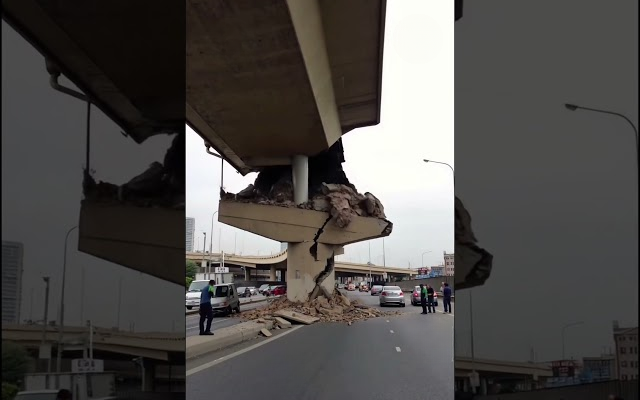A recent earthquake left part of the city’s infrastructure visibly damaged when one of the support columns on a major bridge suffered structural failure. Early images caused alarm among residents, but engineering inspections later confirmed the damage was confined to the bridge’s outer concrete layer, leaving the core framework stable.
The quick closure of the bridge and rapid deployment of emergency teams ensured that no one was injured. While the incident ended without tragedy, it has reignited concerns about the state of public infrastructure in earthquake-prone regions.
Early Morning Tremor and Public Alarm
The quake struck shortly before sunrise, jolting residents awake and sending shockwaves through surrounding neighborhoods. Within minutes, reports began circulating online that a bridge pillar had cracked and partially collapsed.
Local resident Carlos Vega described the scene: “From where I stood, it looked like the whole thing was going to fall. People were scared to even drive near it.”
Traffic authorities acted quickly, sealing off the bridge to all vehicles and pedestrians, and setting up diversion routes to keep traffic moving.
Findings From Structural Engineers
A team of civil engineers arrived soon after to conduct a rapid but thorough evaluation. Their conclusion brought some relief: the visible failure was in the external concrete shell, not in the steel-reinforced core that bears the bridge’s weight.
Dr. Elena Morales, an earthquake-resilient design expert, explained: “The outer layer of concrete is meant to protect the steel reinforcement inside. The quake caused it to crack and break away, but the main load-bearing elements held firm.”
Why Outer Damage Still Matters
Even though the bridge’s core structure was intact, experts stressed that exposed steel can corrode when in contact with moisture and air, leading to long-term weakening.
“If this isn’t repaired quickly, corrosion can start, and that would seriously reduce the bridge’s strength over time,” said Morales.
Earthquake Details and Wider Impact
Seismologists measured the earthquake at magnitude 5.7, with an epicenter roughly 25 miles away. Though moderate, its shallow depth amplified the shaking in built-up areas.
While most damage was minor — cracks in older walls, fallen household items — several public structures, including overpasses and pedestrian bridges, showed signs of strain.
Rapid Emergency Measures
The absence of injuries was credited to the city’s established earthquake inspection protocols.
Transportation Department spokesperson Julia Harper explained: “Once reports of damage came in, we shut the bridge down immediately and had engineers on site within the hour. Public safety will always be our first priority.”
Concerns Over Aging Infrastructure
The incident has renewed calls to upgrade older bridges built decades ago, which often lack the advanced seismic protection of newer designs.
Professor Adrian Lee of the University of California noted: “Many structures from the 1970s and 1980s weren’t built with today’s earthquake science in mind. Retrofitting is essential if we want them to survive future quakes.”
Social Media’s Role
Within minutes of the quake, images of the cracked pillar spread online. Some posts exaggerated the situation, claiming the entire bridge was about to collapse. Officials worked quickly to correct misinformation, but the episode showed how quickly panic can spread during a disaster.
Repair Plans Already in Motion
City engineers have outlined a multi-step repair process:
-
Removing loose concrete to prevent debris hazards.
-
Inspecting and treating any exposed steel for rust.
-
Applying moisture-resistant protective coatings.
-
Rebuilding the damaged outer shell using high-strength materials designed for seismic resilience.
The work is expected to take four to six weeks.
Lessons for the Future
Experts agree that while the bridge held up well enough to prevent disaster, the incident is a reminder that constant maintenance is just as important as strong design.
“It’s not about whether a bridge can survive one quake,” said Lee. “It’s about making sure it’s ready for the next one.”
Citywide Safety Push
In response, several council members are calling for a full review of all major infrastructure, proposing:
-
More frequent bridge inspections.
-
Expanded funding for seismic upgrades.
-
Public reports on infrastructure safety ratings.
Council member Marisol Garcia said: “We have to be proactive, not reactive. Safety checks should be the rule, not the exception.”
Community Response
Businesses near the bridge have adapted delivery schedules to work around detours, and residents say they’re grateful for the quick actions taken to keep everyone safe.
“Yes, it’s inconvenient, but I’d rather be late than in danger,” said commuter David Chen.
Moving Forward
As repairs continue, the damaged bridge will stand as both a warning and a success story — proof that planning, rapid response, and resilient design can prevent a natural disaster from becoming a human tragedy.
Key Points Recap:
-
Damage confined to outer concrete; bridge’s main structure held.
-
No injuries due to swift closures and inspections.
-
Experts stress the need for retrofitting aging infrastructure.
-
Repair work to last 4–6 weeks.
-
Officials push for citywide safety reviews in quake zones.



